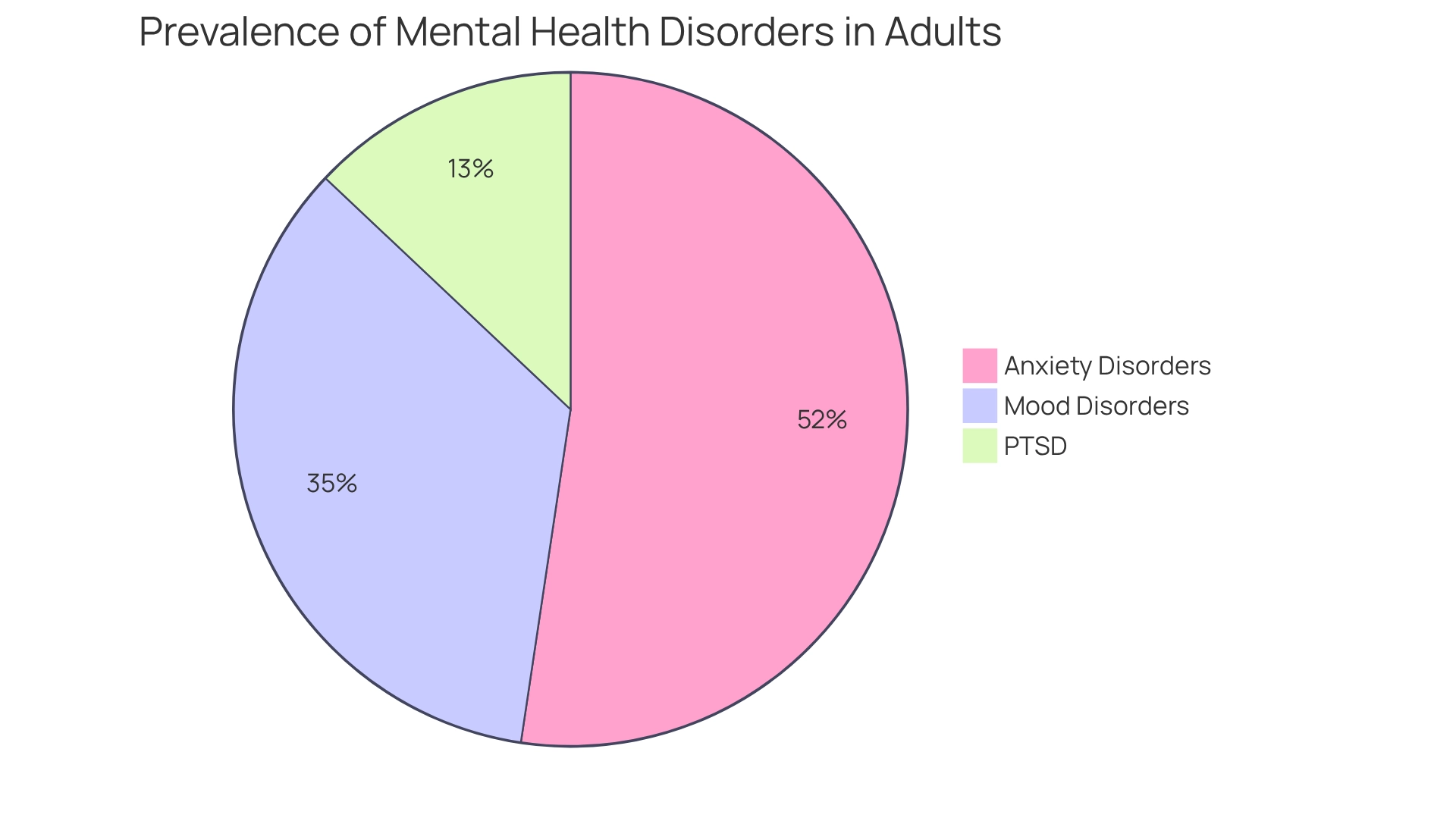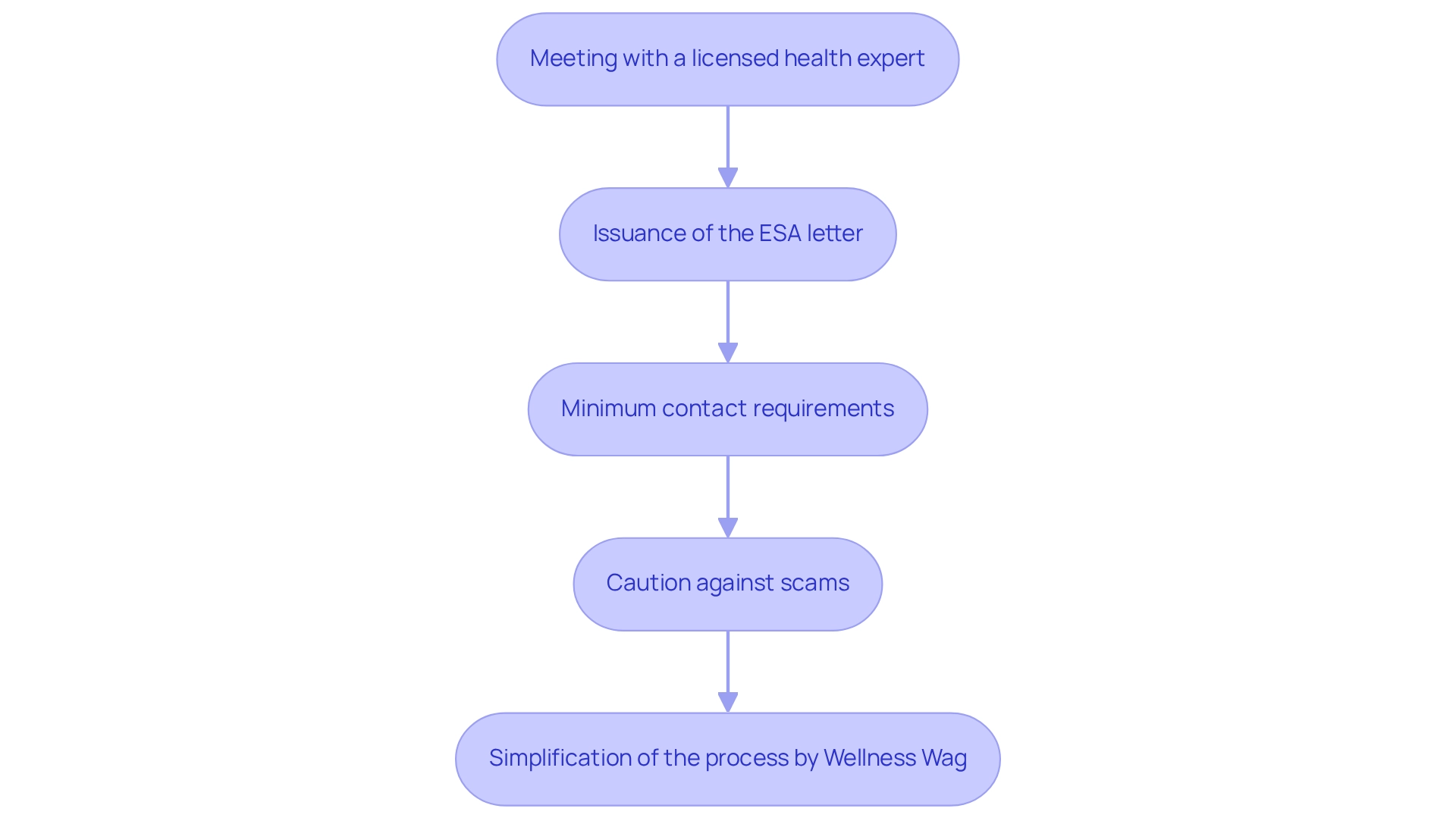

4 Steps on How to Apply for Emotional Support Dog
by Lena Park
Last updated: July 6, 2025
Verified and Approved by:
Angela Morris,
MSW, LCSW
Fact Checked

Overview
Applying for an emotional support dog (ESD) can feel overwhelming, especially when navigating the complexities of mental health challenges. It’s essential to first take a moment to assess your psychological well-being.
Consulting with a licensed health professional is a crucial step in this journey, as they can provide you with an ESA letter. This letter is not just a piece of paper; it serves as a lifeline, offering legal protections and validating your need for an ESD.
The process can be straightforward and supportive when you work with qualified professionals who understand your unique situation. They are there to help you obtain the necessary documentation, ultimately enhancing your mental health and well-being.
Remember, you are not alone in this process, and there are compassionate resources available to support you every step of the way.
Introduction
In a world where mental health challenges are increasingly recognized, many individuals are seeking comfort and stability. Have you ever felt overwhelmed by anxiety, depression, or PTSD? Emotional support dogs (ESDs) have emerged as vital companions, offering unconditional emotional support that can truly make a difference in your life. Unlike service dogs trained for specific tasks, ESDs provide a unique type of comfort that helps alleviate these symptoms.
The bond between humans and their canine companions is not just heartwarming; studies show that nearly half of ESD owners report significant improvements in their mental well-being. As you consider the journey to obtaining an emotional support dog, it’s important to understand the eligibility requirements, secure the necessary documentation, and navigate your legal rights.
This article delves into the essential steps and considerations for those looking to enhance their lives with the help of a furry friend, providing you with the support and guidance you deserve.
Define Emotional Support Dogs and Their Role
Emotional support dogs (ESDs) are more than just pets; they are companions that provide essential comfort and assistance to those grappling with health conditions. Many individuals face emotional challenges, such as anxiety, depression, and PTSD, which can be overwhelming. Unlike service dogs, which are trained to perform specific tasks for individuals with disabilities, ESDs primarily offer companionship and emotional stability. Their presence can significantly alleviate the weight of these psychological issues, fostering a sense of peace and security.
Research indicates a profound connection between humans and animals, with studies showing that 47% of individuals benefiting from ESDs report improved psychological health outcomes. This distinction between ESDs and service dogs is crucial for anyone considering how to apply for an emotional support dog, as it lays the groundwork for understanding the supportive role these animals play in enhancing resilience.
At Wellness Wag, we understand the journey can feel daunting. That’s why we offer a streamlined online process for obtaining legitimate ESA letters through our telehealth services. Our goal is to ensure that individuals can navigate their path with confidence and compassion.
To obtain an ESA letter, individuals must meet specific eligibility requirements, including age, legal capacity, and adherence to local laws. Our platform simplifies the process, allowing individuals to acquire an ESA letter through licensed health professionals or general practitioners, and if you have questions about how to apply for an emotional support dog or the application process, we invite you to explore our FAQ section.
Remember, you are not alone in this journey. Support is available, and we are here to help you every step of the way.
Assess Your Eligibility for an Emotional Support Dog
Evaluating your suitability for an assistance dog begins with a thoughtful assessment of your psychological well-being. In the United States, many adults face challenges with mental health—approximately 31.1% experience anxiety disorders, 20.6% suffer from mood disorders, and 7.7% are diagnosed with PTSD. If you find yourself relating to these statistics and believe that a therapy dog could enhance your well-being, the next step is to understand how to apply for an emotional support dog by reaching out to a licensed health professional (LHP). During this consultation, the LHP will conduct a comprehensive evaluation of your psychological health and how it impacts your daily life. They will help determine if a comfort animal is the right choice for you.
It’s important to understand how to apply for an emotional support dog, as a formal diagnosis is typically required to qualify for an ESA letter, which is crucial for legal protections under the Fair Housing Act and other regulations. To further explore your eligibility, consider these criteria:
- A documented mental health disorder such as anxiety, depression, or PTSD
- The potential for a companion animal to alleviate symptoms related to your condition
- A recommendation from a licensed mental health professional tailored to your specific needs
Case studies reveal the significance of proper documentation. For instance, students navigating ESA policies in colleges have successfully advocated for their rights to have ESAs in housing, even in no-pet environments, by adhering to established procedures and obtaining the necessary documentation from LHPs. This demonstrates how proper documentation can facilitate access to housing for those who need assistance.
While there are no formal training prerequisites for assistance animals, a temperament assessment by an animal behaviorist is advisable to ensure that the pet is suitable for the role. As noted by Chum, ‘Given that formalized training requirements for ESAs don’t yet exist, there’s always the possibility your animal could behave unpredictably and do more harm than good.’ This proactive approach can help alleviate potential issues, as the behavior of an ESA can significantly influence its effectiveness in providing psychological support.
Furthermore, it’s essential to recognize that not all businesses are legally obligated to allow ESAs, which can impact your rights as a pet owner. For those considering how to apply for emotional support dog benefits, Wellness Wag offers flexible payment options starting at $32.25, making it easier for individuals to pursue the advantages of animal companionship.

Obtain Your ESA Letter from a Licensed Professional
To understand how to apply for an emotional support dog, follow these steps:
- Arrange a meeting with a licensed health expert, such as a therapist, psychologist, or psychiatrist to obtain your ESA letter. During this consultation, it’s vital to openly discuss your psychological health condition and how a therapy dog could aid in your treatment. As Jackie Brown wisely states, “No, ESA letters are not difficult to obtain as long as a licensed health professional diagnoses you with a qualifying psychological condition and assesses your need for an emotional support animal.” This highlights how accessible the process can be when you collaborate with qualified professionals.
- If the professional determines that an ESA is beneficial, they will issue a signed letter on their official letterhead that includes information on how to apply for an emotional support dog. This letter must include your name, the date, and the professional’s license information. It’s essential that the letter is both dated and signed, as this documentation plays a crucial role in securing housing and travel accommodations.
- It’s important to note that certain states require a minimum of 30 days of contact between you and the licensed health professional before you understand how to apply for emotional support dog letters. This ensures a thorough evaluation of your needs.
- Additionally, please be cautious of online services that offer ESA registration or certification without proper evaluation, as these are often scams. By working with qualified professionals, you can feel confident that your ESA letter is legitimate and effective in supporting your mental health needs.
- Moreover, acquiring an ESA letter via Wellness Wag simplifies the process, making it easier for students to access the assistance they require in university accommodation.

Understand Your Rights and Responsibilities with an ESA
Understand Your Rights and Responsibilities with an ESA
Are emotional support animals (ESAs) entitled to specific rights?
Absolutely. As an ESA owner, you enjoy specific rights under the Fair Housing Act (FHA) and the Air Carrier Access Act (ACAA). These regulations empower you to share your living space with your ESA, even in residences that typically prohibit pets, and to travel with your ESA on airlines that welcome assistance animals. It’s heartening to note that approximately 67% of ESA owners report enhanced mental health thanks to their animal’s companionship, underscoring the significance of these rights.
What responsibilities come with these rights?
With these rights, however, come meaningful responsibilities. It’s essential to ensure that your ESA behaves well in public settings and does not cause disturbances. This involves managing your pet’s conduct to prevent any disruptions that could affect others around you. Legal expert Katie Verling reminds us that “responsible ownership is key to maintaining the rights granted under the FHA and ACAA.”
How do service dogs vary from comfort animals?
While service dogs enjoy full public access rights under the Americans with Disabilities Act (ADA), emotional support animals do not share the same level of access. Service dogs are trained to perform specific tasks for individuals with disabilities. Although there is no legal requirement for service dogs to be certified or registered, obtaining certification can lend credibility and ensure that the dog meets certain standards, which is beneficial for responsible ownership. In contrast, ESAs primarily provide comfort and psychological support, recognized under various legal frameworks.
What documentation is needed for an ESA?
Landlords and housing providers may request documentation to verify your need for an ESA, making it vital to keep your ESA letter easily accessible. This letter serves as proof of your eligibility and can facilitate smoother interactions with property managers. For example, a family navigating a pet-restricted apartment complex found that having an ESA letter helped them secure housing despite initial resistance from the landlord.
Why is it important to understand these rights and responsibilities?
Understanding these rights and responsibilities not only aids you in navigating housing and travel challenges but also reinforces the importance of being a responsible ESA owner. Currently, ESA owners face legal hurdles, including disputes over the validity of ESA letters and the evolving regulations surrounding emotional support animals. Therefore, staying informed and proactive is more crucial than ever.
Conclusion
The journey to acquiring an emotional support dog (ESD) is filled with meaningful steps that can significantly enhance mental well-being. For individuals grappling with anxiety, depression, or PTSD, understanding the unique role of ESDs—primarily as companions offering emotional stability—is crucial. With nearly half of ESD owners reporting improved mental health outcomes, the bond between humans and their canine companions emerges as a powerful source of comfort.
Eligibility for an ESD begins with a thorough assessment of one’s mental health, ideally conducted by a licensed mental health professional. This evaluation is essential not only for obtaining the necessary ESA letter but also for ensuring that an emotional support dog is a suitable option for your specific needs. Proper documentation plays a pivotal role in securing legal protections and facilitating access to housing, highlighting the importance of following established procedures.
Once the eligibility criteria are met, obtaining an ESA letter through a licensed professional streamlines the process and provides the necessary documentation to advocate for your rights as an ESA owner. Understanding the rights and responsibilities associated with owning an ESD, particularly under the Fair Housing Act and the Air Carrier Access Act, empowers you to navigate housing and travel challenges effectively.
In conclusion, emotional support dogs represent more than just pets; they are vital companions that can significantly improve mental health and overall quality of life. By following the proper steps to assess eligibility, obtain documentation, and understand legal rights, you can confidently embark on the journey to enhance your emotional well-being with the support of a furry friend. Remember, you are not alone in this journey; support is available to guide you every step of the way.
Frequently Asked Questions
What are emotional support dogs (ESDs)?
Emotional support dogs (ESDs) are companions that provide essential comfort and assistance to individuals dealing with emotional challenges such as anxiety, depression, and PTSD. They primarily offer companionship and emotional stability rather than performing specific tasks like service dogs.
How do ESDs differ from service dogs?
ESDs differ from service dogs in that they are not trained to perform specific tasks for individuals with disabilities. Instead, ESDs focus on providing companionship and emotional support to help alleviate psychological issues.
What benefits do individuals experience from having an ESD?
Research shows that 47% of individuals benefiting from ESDs report improved psychological health outcomes, indicating a significant positive impact on emotional well-being.
How can someone obtain an emotional support animal (ESA) letter?
To obtain an ESA letter, individuals must meet specific eligibility requirements, including age and legal capacity, and adhere to local laws. The process can be simplified through licensed health professionals or general practitioners, often available through telehealth services.
What services does Wellness Wag offer for obtaining ESA letters?
Wellness Wag provides a streamlined online process for acquiring legitimate ESA letters through telehealth services, helping individuals navigate their journey with confidence and compassion.
Where can individuals find more information about applying for an emotional support dog?
Individuals can explore the FAQ section on the Wellness Wag platform for more information about how to apply for an emotional support dog and the application process.
Certify Your Emotional Support Animal Today

Why You Can Rely on Us?
At Wellness Wag, we believe your pet deserves care rooted in both science and compassion. Each article is carefully researched, written in clear language for pet owners, and then reviewed by qualified professionals to ensure the information is evidence-based, current, and practical for real-life care. Our goal is to help you feel confident in making informed decisions about your pet’s health and well-being.
Reviewed by
Angela Morris, MSW, LCSW
Angela is a licensed clinical social worker with 20 years of experience in patient advocacy and community mental health. She has assisted numerous clients with ESA evaluations and brings a deep understanding of disability accommodations, ensuring that all information is accurate, supportive, and practical.

Written by :
Lena Park
Last Updated :
July 6, 2025












